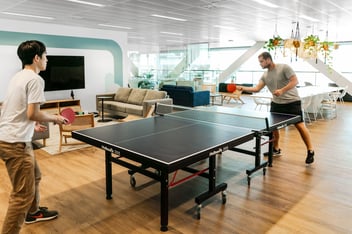Peace is hard to find in the office. Constant chatting, keyboards tapping, and music blasting can interrupt employees, impacting productivity and affecting their wellbeing at work. Noise is one of the top disrupters to employees and costs Australian businesses billions in absenteeism and staff turnover. Organisations need to ensure their people are well looked after, both mentally and physically, and this can be achieved by adding quiet zones.
A study by Steelcase found 95 percent of employees today need quiet and private areas, but only 40 percent say their workplaces provide them.
Some of the largest companies in the world have engaged in innovative workplace design by dedicating quiet spaces to help their employees unwind and de-stress at work. Salesforce added a meditation room to each level of its San Francisco offices and SRAM has outdoor meeting spaces and rooftop gardens for its employees. Google, Facebook and Nestle use pods to create privacy for both focused work concentration and short nap breaks. While these companies use different tactics to increase productivity and support the wellbeing of their employees, they share the same goal of effectively meeting the needs of their employees.
A study by Steelcase and Ipsos found employees in open-plan offices lost 86 minutes of productivity a day, due to noise distractions, and 49 percent were unable to concentrate easily.
Quiet spaces don’t have to be elaborate or expensive. Building a space for an entire garden or outdoor area may not be plausible in a 60-storey building. However, small and clever changes to your workplace design can help your people really benefit. If productivity is decreasing, and noise and disruptions are increasing, consider what you can do immediately to cut the negative effects to employee wellbeing at work. Here are eight ideas to get you started:
Use furniture to define spaces
Couches, lounges and moveable tables can be utilised to turn one corner of the office into a private area for an employee.
Create flexible boundaries
Use portable whiteboards, curtains, screens and dividers to allow your employees some private or quiet time.
Design unassigned, enclosed spaces
Turn a large meeting room into smaller ones by adding glass screens. The glass gives the impression of being private while allowing for visibility.
Outdoor improvements
Not every office will have an outdoor space. However, if you do, encourage your employees to use it by adding some tables and chairs, and accessibility to power.
Make one corner of the office a silent zone
Use a screen to mark a corner of the office as a silent zone. Remind employees they can use it whenever they want, but it must be a tech-free and noise-free area.
Encourage employees to signal private time
A quiet space for your employees might be as simple as urging them to use headphones at work to signify they’re unavailable and need peace.
Sound proof your breakroom
Consider adding ceiling panels that absorb and cut noise to separate your employees from background work noise.
Introduce greenery and light
Make an indoor garden beside a window with sunlight that encourages employees to sit in, soak up Vitamin D, and get work done. Studies have shown employees perform up to 25 percent better with a view outside. Alternatively, think about bringing more light to the office, or reducing eye-strain.
Read more: How office lighting impacts productivity
Whether it’s something as simple as a canvas folding screen, or elaborate as a garden, your employees need a separate space to unwind. Encouraging the use of different spaces for different purposes is also important – one silent space may be just for relaxing and contemplation, while another is for quiet work. The important part of office design is showing your people you support their ongoing health and wellbeing, and appreciate their work.
Axiom uses innovative design to optimise productivity in your employees and encourage them to feel comfortable at work. Find out more about us.






